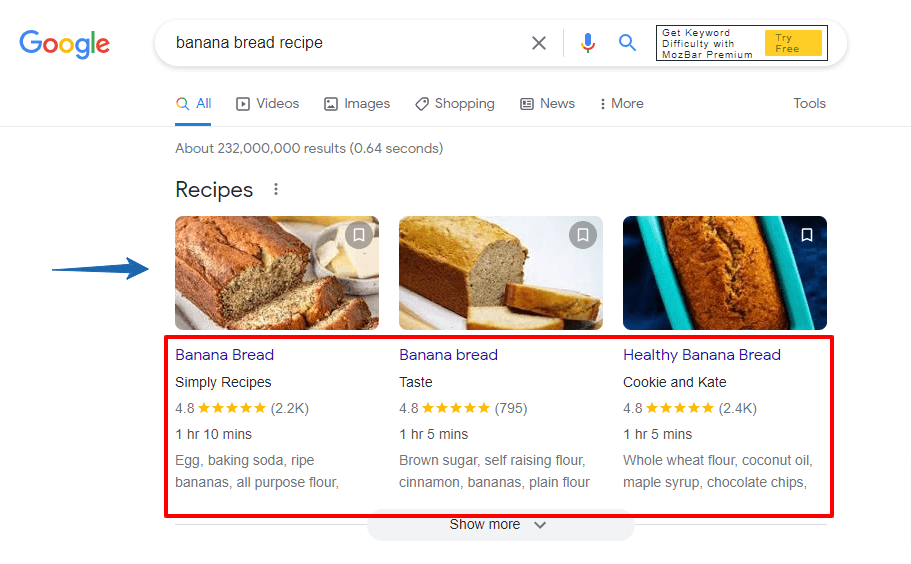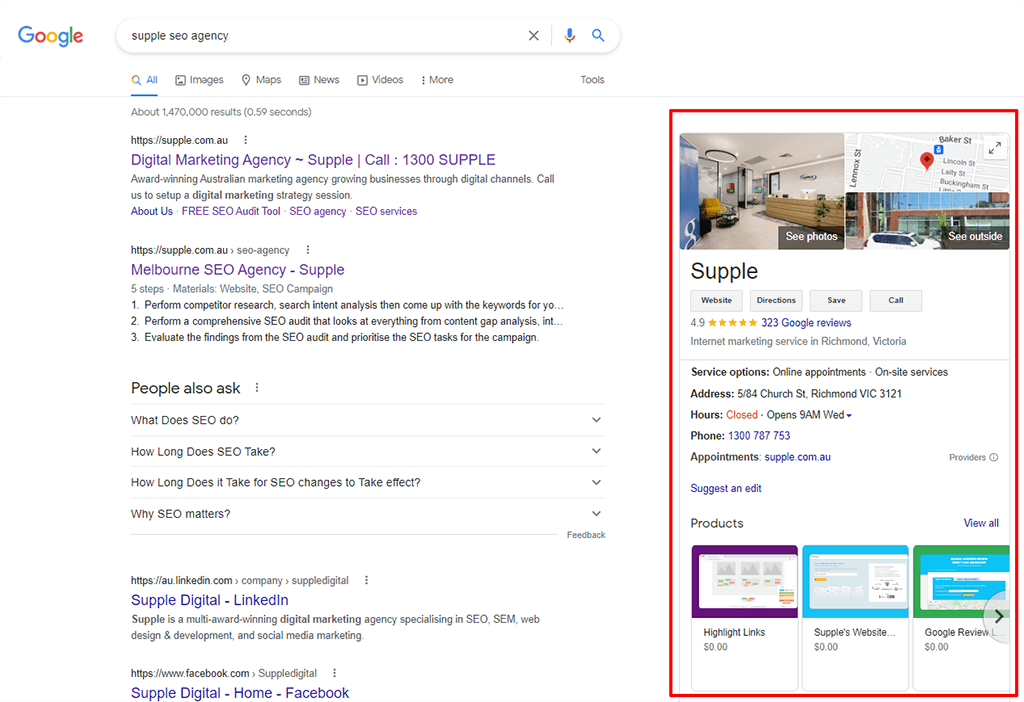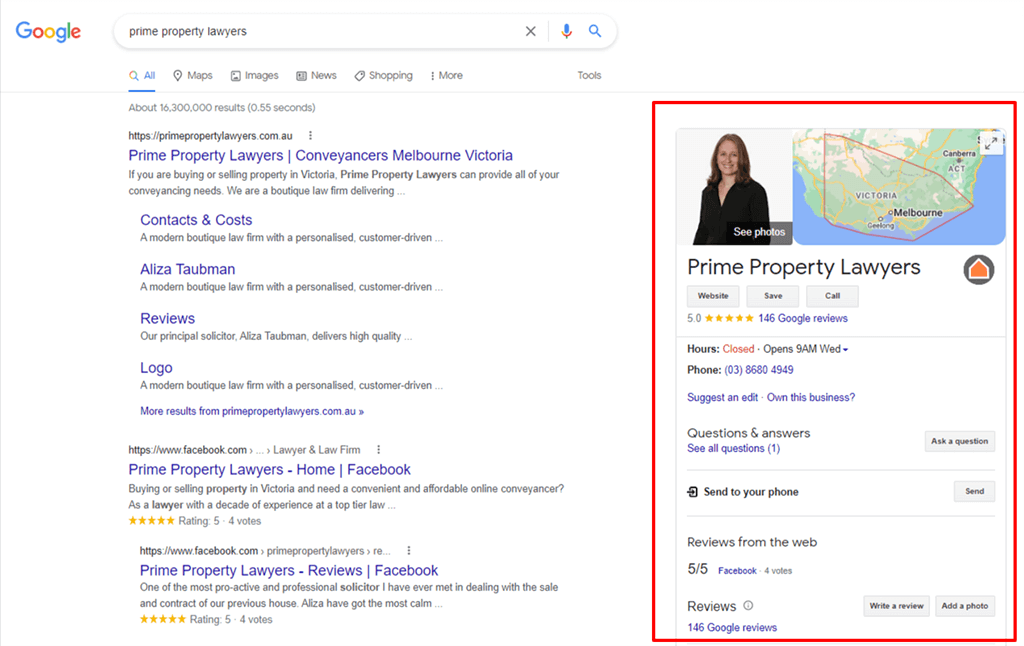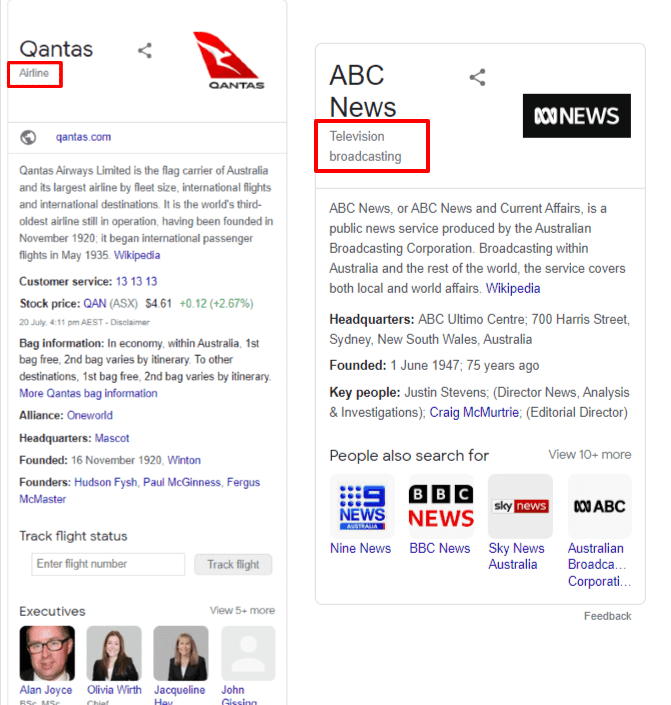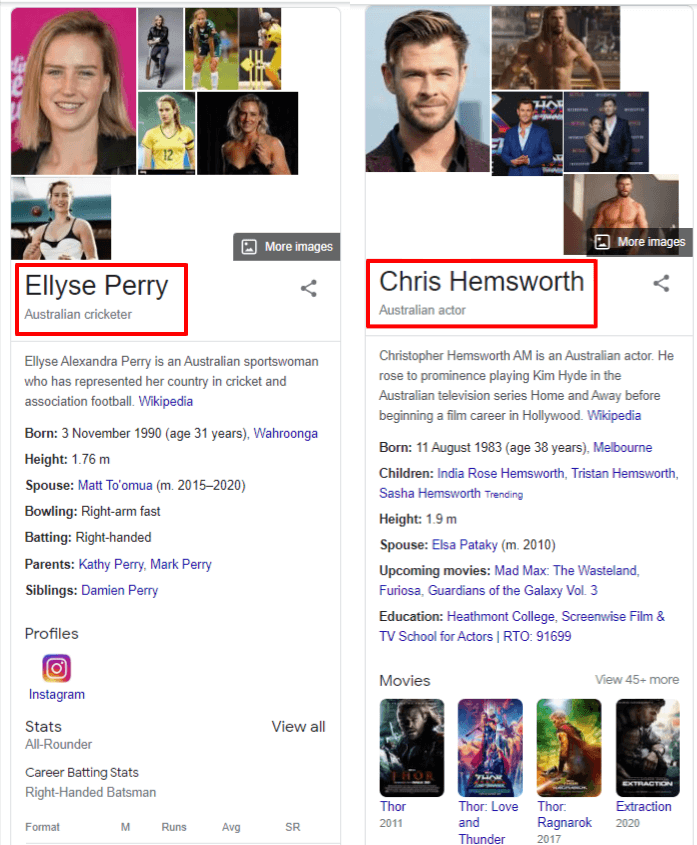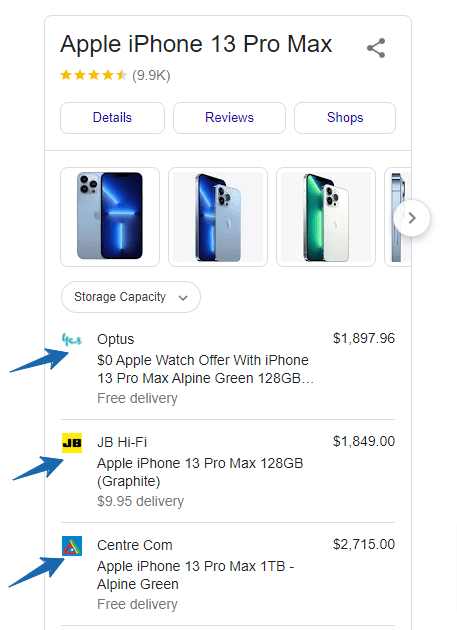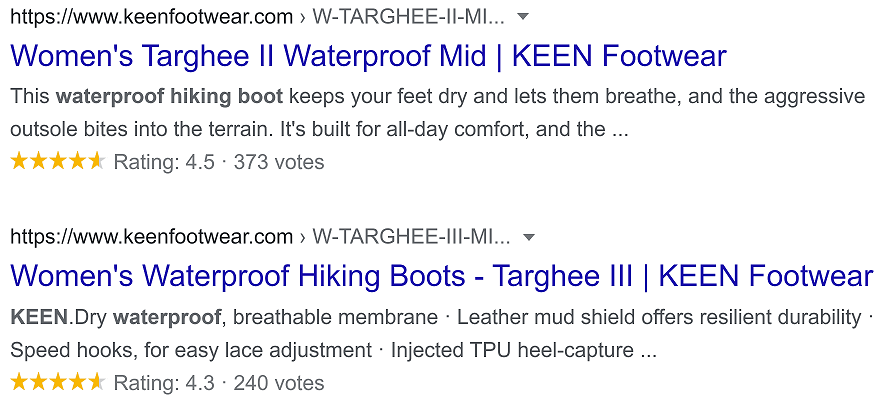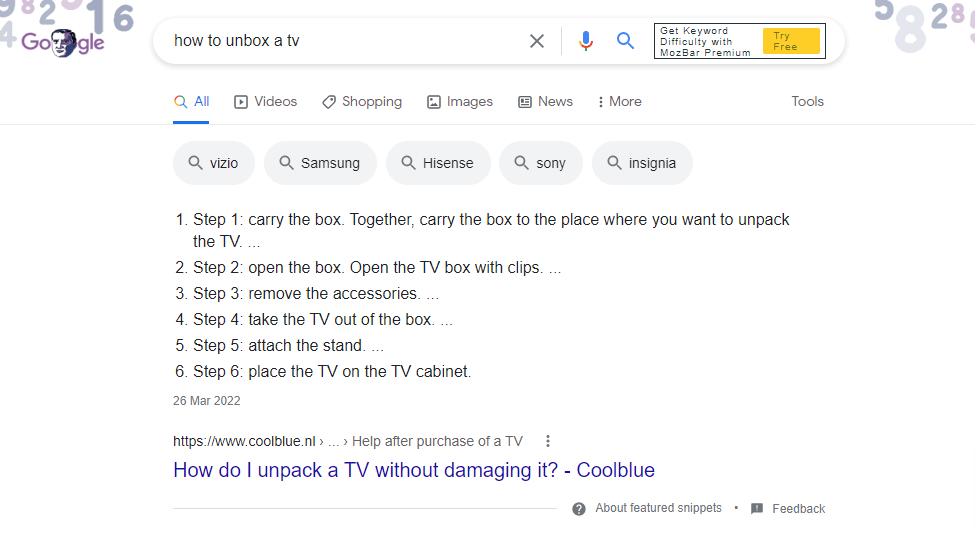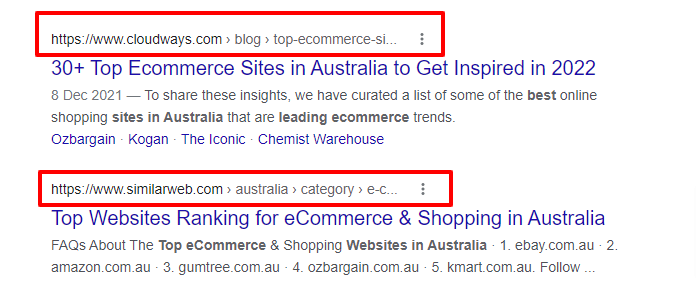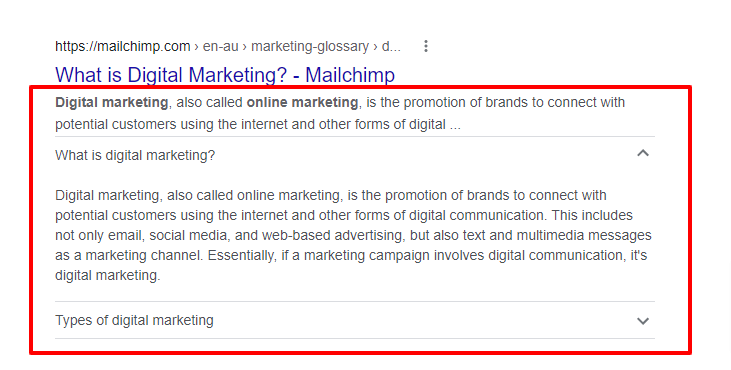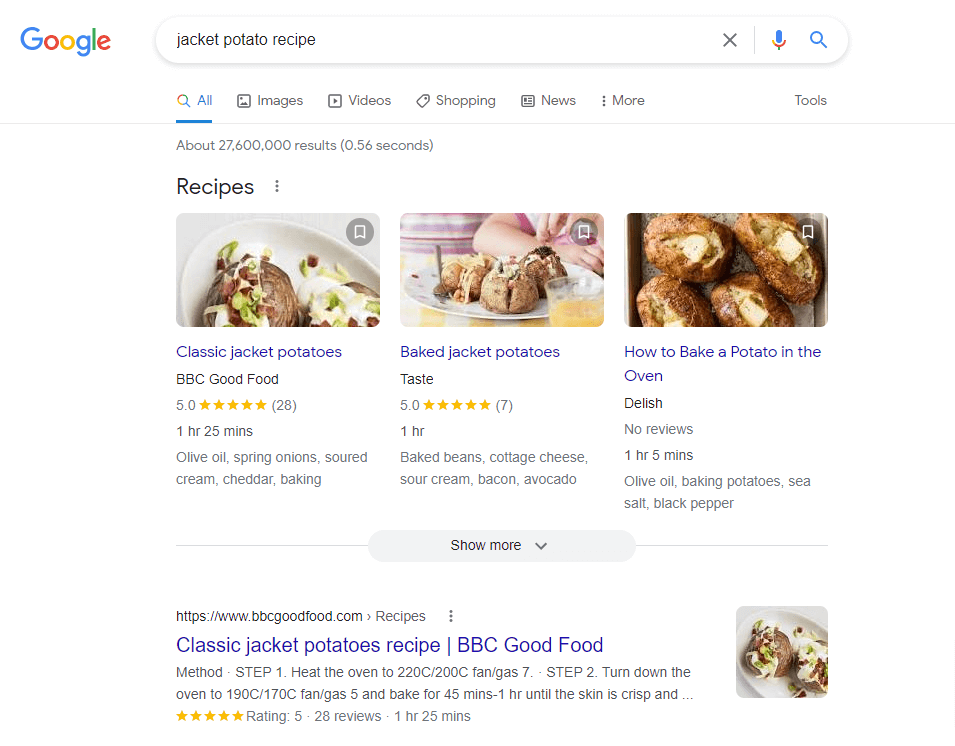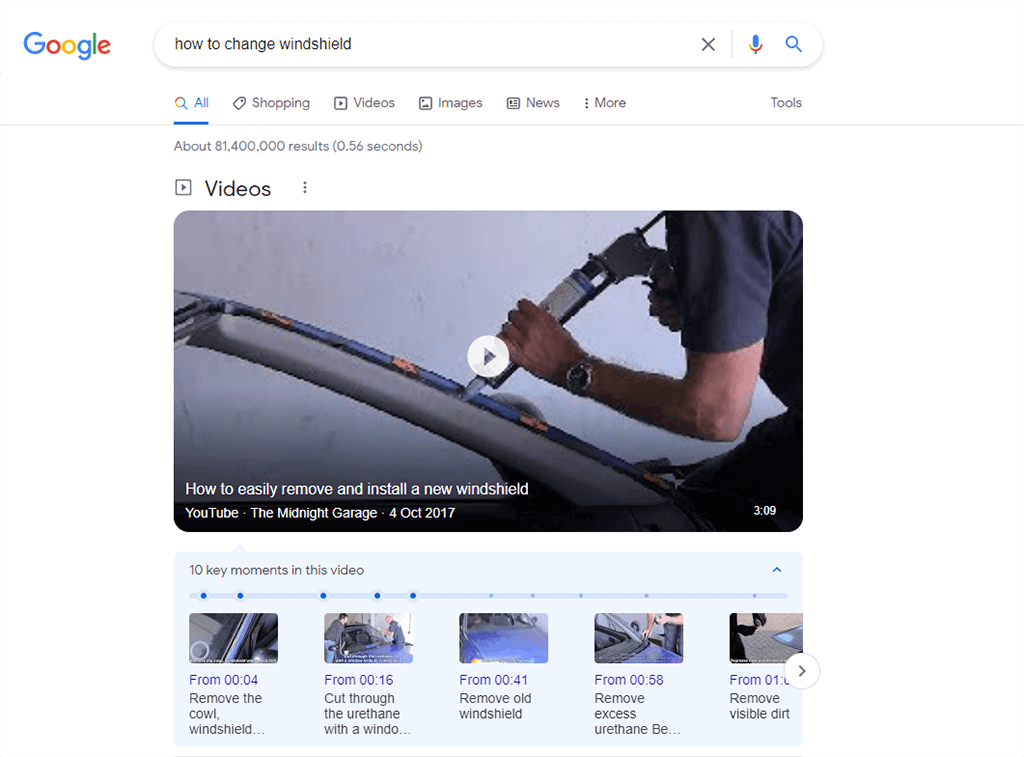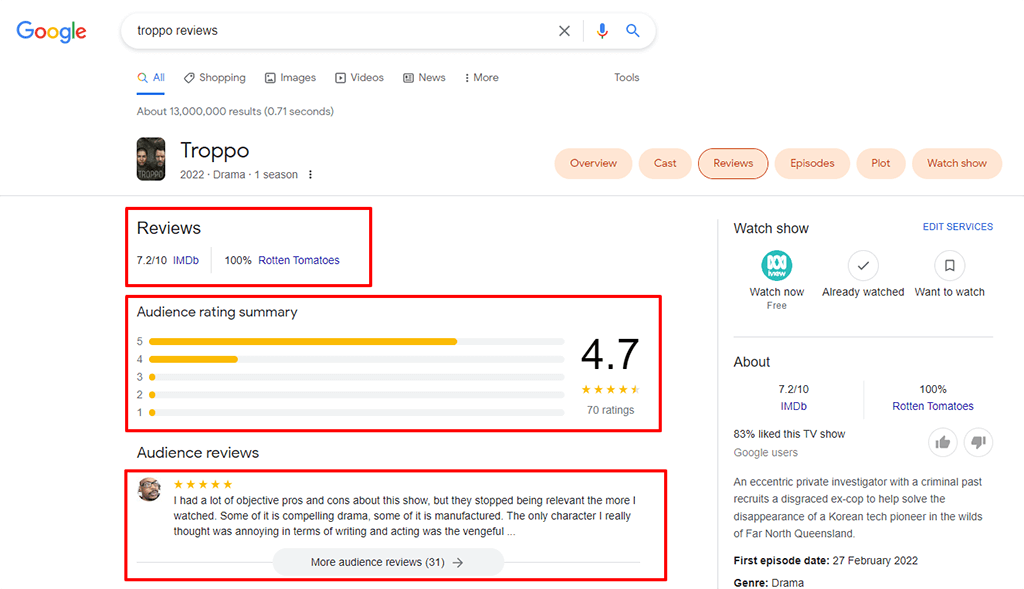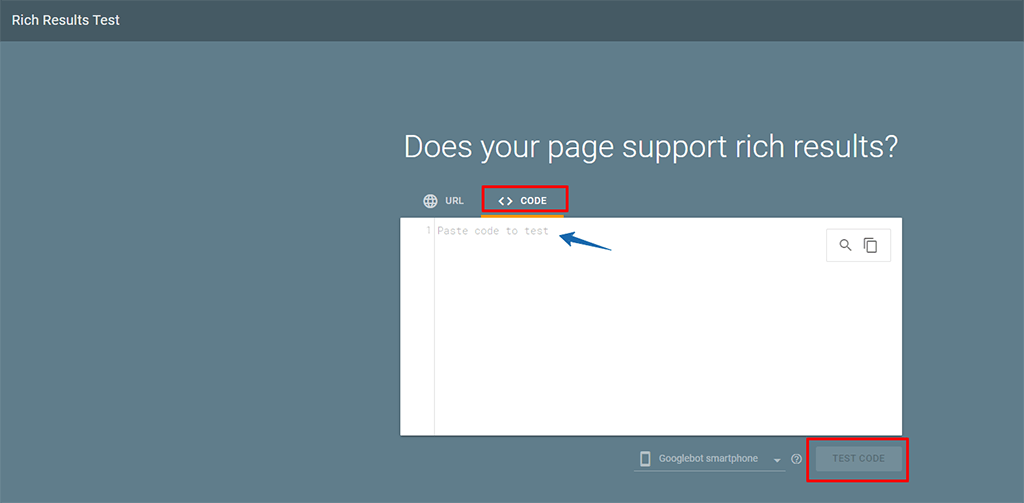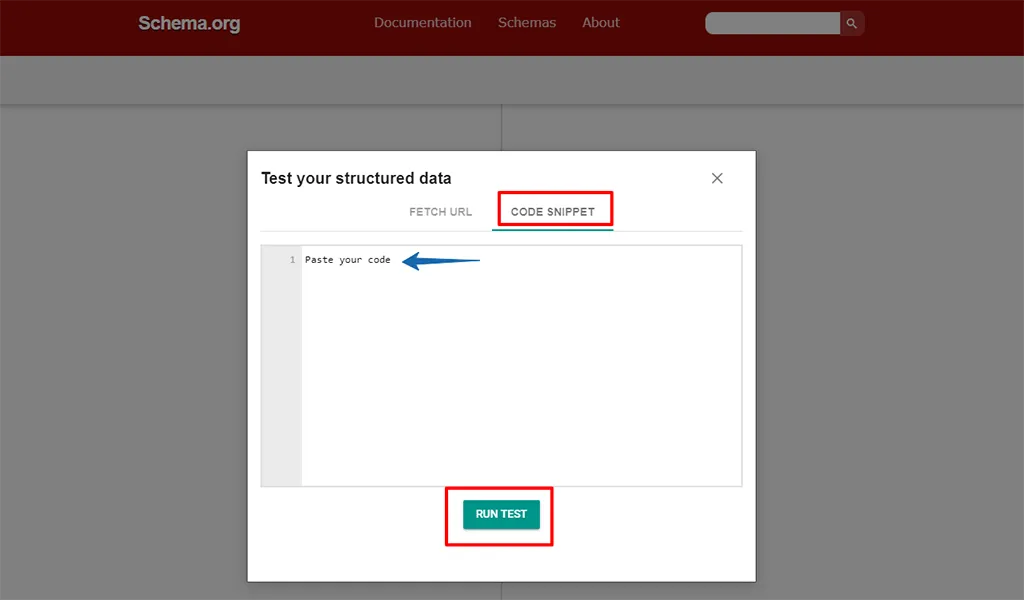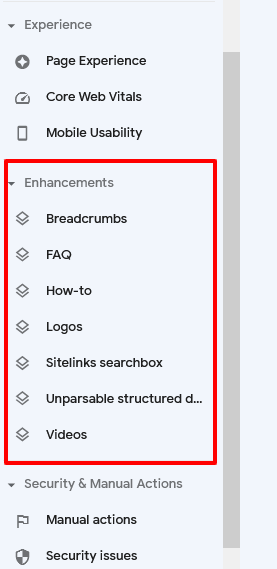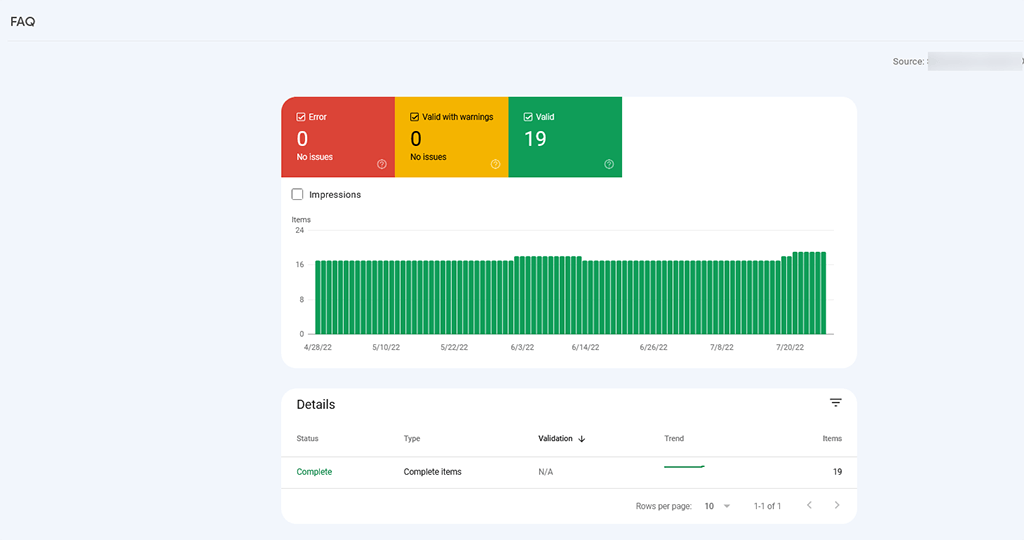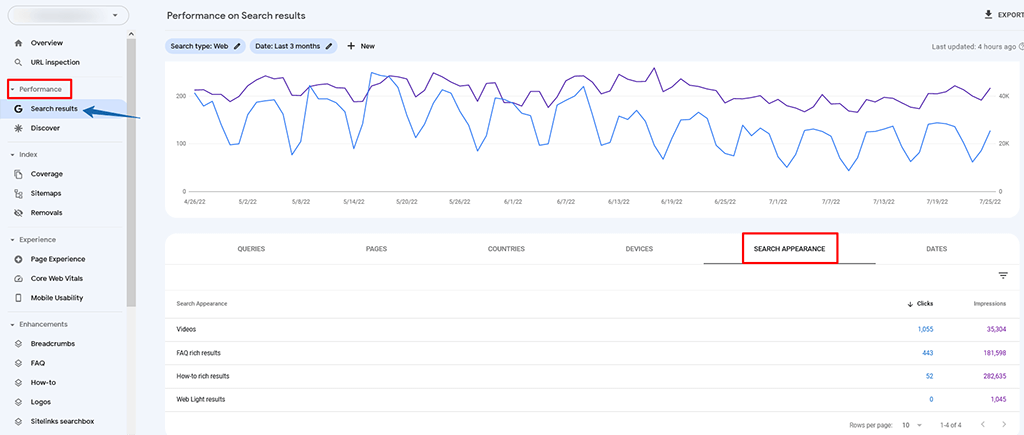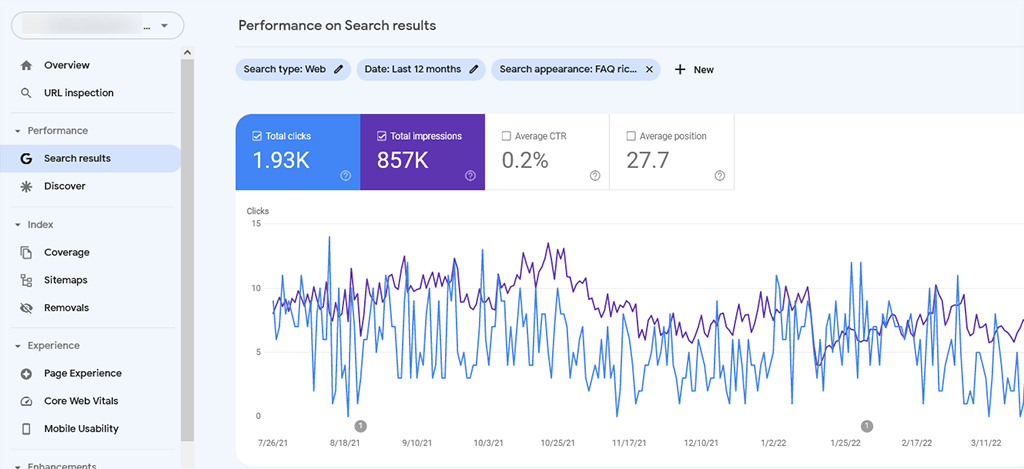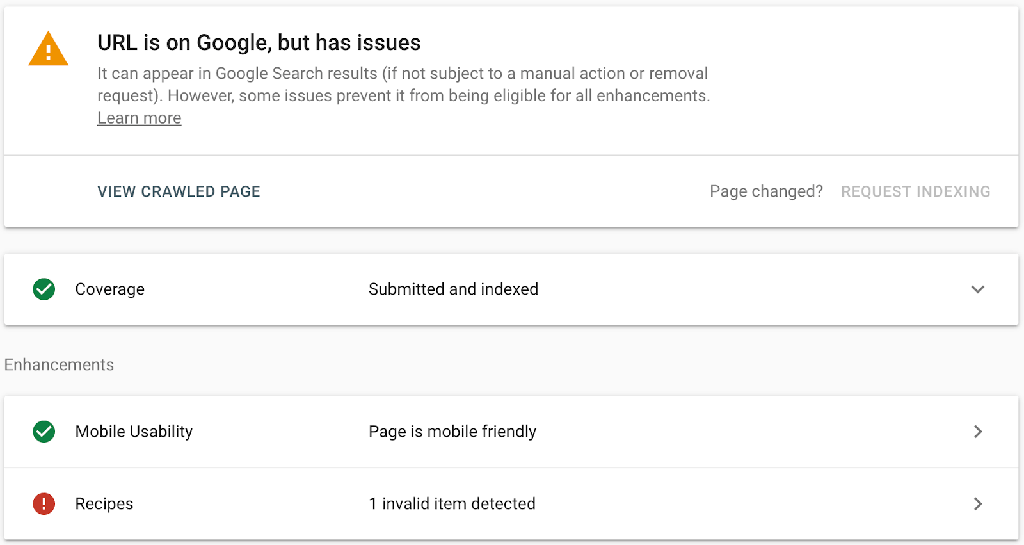
Structured data optimisation is the process of improving the way information is presented on a website so that it can be easily understood by search engines. This results in better visibility for a website in search engine results pages, as well as improved click-through rates. Supple’s structured data optimisation service will improve your search engine visibility and SEO performance, contributing to more traffic, leads, and paying customers for your business.
Get the Insider Information You Need to Boost Your Website’s Rankings – Free SEO Audit!
What is Schema Markup and How Does it Help your SEO?
When you search Google and browse through the results, there are high chances that you’d end up clicking the result that has more information about the on-page content on SERPs.
Here, when we say more information, it could be in the form of images, videos, product information, reviews, etc. In other words, you may see some results with such enhanced information. That’s why you get compelled to click through such Rich Results.
Similarly, your audience may also get attracted to explore the rich snippets they see on SERPs.
Now, the question is: How can you have your pages get featured with rich snippets?
Schema Markup can help you do that.
Moreover, schema markup can also help you improve your overall SEO performance in many ways.
So let’s dive in and understand everything you need to know about schema markup.
Schema Markup—also referred to as Schema—is microdata (code) you can add to your site’s HTML. It helps search engines understand your content better and, consequently, return more detailed and descriptive results for users.
Take a look at the below image. You might have seen such rich snippets for some of your search queries on Google.
Once you add schema to your pages, it gives Google additional context about your pages.
How does Schema Markup Work?
Schema markup matches names and values to help search engines categorise and index your pages. Structured data works with HTML5 which is the most popular major markup language.
You can use schema markup to add information about values in categories such as organisation, event, creative work, medical entity, person, place, etc.
Google Search supports structured data in below three formats:
- JSON-LD
- RDFa
- Microdata
What are JSON-LD, RDFa, and Microdata?
JSON-LD, RDFa, and Microdata are all code languages that you can add to HTML for implementing schema on a web document.
That said, let’s learn a bit more about these languages.
JSON-LD
JSON-LD is an abbreviation of JavaScript Object Notation for Linked Data. JSON-LD code can be directly added to the HTML <head> or <body> tag of the page. That’s why it’s also one of the easiest ways for beginners to apply schema.
Besides, when you insert JSON-LD data dynamically (with JavaScript or embedded widgets) into the page content, Google can read that too.
Here are the pros and cons of using JSON-LD for schema:
| Pros | Cons |
|---|---|
| Recommended by Google and supported by all browsers | No namespace support |
| Concise format | Limitations in supporting development tools |
| Fully automated way to serialise or deserialise JavaScript | No support for formal grammar definition |
| Simple API | No support in application servers, ESBs, etc. |
| Supports multiple AJAX toolkits | |
| Flexibility to place the script anywhere in HTML |
RDFa
RDFa (Resource Description Framework in Attributes) is an HTML5 extension that supports HTML tag attributes which denote user-visible content you want to describe Google. It can be applied to both—the head and body of the page.
Here are the pros and cons of using RDFa for schema:
| Pros | Cons |
|---|---|
| Works well with most schema types | Requires developer work and design changes |
| Can be applied to any HTML, XHTML, or XML-based document | Requires more coding know-how as compared to JSON-LD markup |
| Supports linked data with HTML tag attributes | Difficult to implement as compared to JSON-LD |
Microdata
Microdata is an open-community HTML specification that helps embed structured data within HTML content. It also uses HTML tag attributes to identify properties you want to introduce as structured data.
Ideally, you should add microdata to the page body, but you can also apply it to the head if need be.
Here are the pros and cons of using Microdata for schema:
| Pros | Cons |
|---|---|
| Allows search engines to index microdata tags | Requires design and development support for every change |
| Allows search engines to potentially use the data to enhance their search results listings | Requires more coding know-how as compared to JSON-LD markup |
| Supports the presentation of rich snippets | Only a very small percentage of sites |
| within search results | currently use Microdata |
| It’s an open-community HTML | Difficult to implement as compared to JSON-LD |
| Typically used in page body |

OUR SEO PROCESS
The First Page of Google!
Research
In this phase, our SEO consultants will work with you to understand your business and define the goals of our SEO campaign. We will perform competitor research and search intent analysis before identifying the keywords that we think you should target.

Audit
Our comprehensive SEO audit looks at everything from content gap analysis and internal links to site architecture, backlink profiles, technical SEO, and crawl optimisation. Our team will identify all the growth opportunities based on your current website and SEO performance.

Strategy
In the strategy phase, we evaluate the findings from our audit and prioritise SEO tasks. We have an Impact / Effort / Action Priority Matrix that we follow to prioritise tasks. Our SEO specialists create an action plan for your SEO campaign, which includes a timeline with key milestones we have to achieve.

Implementation
Our SEO team, designers and developers work with you to start actioning the high priority tasks from the previous phase. Following this, we get onto the low priority tasks. This process allows us to knock out some early quick wins, then have a strategy in place to tackle the high effort tasks. We keep the low rewards tasks on the back burner and tackle them when we get time as the campaign progresses.
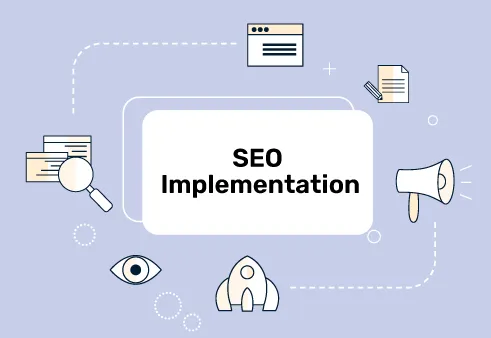
Reporting
We have systems and processes in place to make sure that we track and report on your SEO campaign.
As you can imagine, this is not the end. Our SEO consultants are constantly analysing and tweaking your campaign to achieve the best possible results on the 1st page of Google. It is an ongoing process, and we are with you for the long term!

Research
In this phase, our SEO consultants will work with you to understand your business and define the goals of our SEO campaign. We will perform competitor research and search intent analysis before identifying the keywords that we think you should target.

Audit
Our comprehensive SEO audit looks at everything from content gap analysis and internal links to site architecture, backlink profiles, technical SEO, and crawl optimisation. Our team will identify all the growth opportunities based on your current website and SEO performance.

Strategy
In the strategy phase, we evaluate the findings from our audit and prioritise SEO tasks. We have an Impact / Effort / Action Priority Matrix that we follow to prioritise tasks. Our SEO specialists create an action plan for your SEO campaign, which includes a timeline with key milestones we have to achieve.

Implementation
Our SEO team, designers and developers work with you to start actioning the high priority tasks from the previous phase. Following this, we get onto the low priority tasks. This process allows us to knock out some early quick wins, then have a strategy in place to tackle the high effort tasks. We keep the low rewards tasks on the back burner and tackle them when we get time as the campaign progresses.

Reporting
We have systems and processes in place to make sure that we track and report on your SEO campaign.
As you can imagine, this is not the end. Our SEO consultants are constantly analysing and tweaking your campaign to achieve the best possible results on the 1st page of Google. It is an ongoing process, and we are with you for the long term!


While it’s a known fact that schema markup is not a ranking factor, it certainly helps you boost your SEO performance.
There are a ton of schema markups available for different types of content. You can check the entire list of available schema types on Schema.org.
Schema.org is a reference site that contains a set of documentation and guidelines to help you use structured data correctly on your webpages.
That said, here are some of the most commonly used schema markups that you’d see on Google SERPs:
- Organisation schema markup
- Person schema markup
- Product schema markup
- Article schema markup
- HowTo schema markup
- Breadcrumbs schema markup
- FAQ schema markup
- Recipe schema markup
- Video schema markup
- Reviews and Rating schema markup
We’ve also covered each of the above schema markup types in detail in Chapter 3. But first, let’s look at the ways schema markup helps your SEO.
Here they are:
Improves your Site’s Crawlability
To serve results in SERPs, Google needs to understand what the page is all about. By adding schema, you’re informing Google what’s exactly on your page which in turn helps Google crawl, index, and render your pages for relevant searches.
Here’s how Google gets the whole picture of your webpages:
It understands what’s covered on the page through your content. Whereas, it establishes the relationship between different entities on your page through schema. For instance, product schema informs Google about your product offering.
Thus, schema markup is an opportunity to outline details that make search engines’ work easier. In return, your site’s crawlability and indexability improve.
Enhances your Brand Visibility on SERPs
Google serves users additional details of your page with features like rich snippets, knowledge graphs, etc. This helps users get relevant information instantly right there on SERPs.
For instance, say you own a small business and your site is optimised for the local business schema. Now, when your target audience searches for your brand or services, they can get the first glance of your business details like opening hours, address, contact information, etc. in the knowledge graph.
This establishes a sense of trust and authority in the eyes of your target audience.
Boosts your Site’s Click-through Rate
Applying schema markup helps you add more value to your organic results by making them visible, engaging, and attractive to users. Also, your listing would occupy more space in the search results.
As a result, your click-through rate (CTR) can also improve since users are more likely to click on such results as compared to ones without schema. With higher CTRs, your search rankings would also improve.
If you’re still unsure whether your business site needs a schema markup, you can consult an SEO expert or a competent SEO agency for better clarity.
Case Studies
Return on Investment for business owners.
Currently, there are a total of 797 types of schemas available that you can mark depending on the type of content on your website. However, let’s look at the schema types that have the highest SEO value.
Organisation
Organisation and Local Business schema is a crucial markup for your business website. Consider adding this schema type to pages like Homepage, About Us, Contact Us, etc. in addition to setting up your Google Business Profile.
This helps you establish your business details with Google and build an entity around your website. You should add the below information (minimum) to the organisation schema:
- Company name
- Address
- Type of business
- Official website
- Brand logo and images
- Your preferred business description
- Contact information
- Social media accounts
Once you mention all the information about your business in the schema, Google may reward you with a knowledge graph space in SERPs.
Here’s what an organisation knowledge graph looks like:
Besides, Schema.org has also provided structured data guidelines for specific types of businesses such as:
- Airlines
- Corporations
- Educational organisations
- Government organisations
- Local businesses
- Medical organisations
- NGOs
- News media organisations
- Online businesses, and more…
For instance, if you own a local business, you need to add the details that are relevant to the local business schema to get featured with a knowledge graph in SERPs.
Alternatively, you can also use a Local Business Schema Generator to generate the structured data markup code which you can copy and paste to the footer of your contact us page.
Here’s an example of a local business knowledge graph:
Also, check these examples of the Airline and News Media Organisation knowledge panel.
Person
Person schema can help you establish your identity as an individual entity on Google search. As with any type of structured data, there’s no certainty about the results. As you keep building your authority with consistent efforts, eventually Google may feature a knowledge panel.
The simplest way to earn this type of panel is by focusing your digital efforts around Google’s E-A-T criteria. It revolves around three main factors: building Expertise (E), Authority (A), and Trust (T) in your industry with your work and relevant content creation.
That said, here’s an example of our solid expertise and authority in the SEO industry and Google’s reward—individual entity knowledge panel—to our SEO Strategy Director.
Furthermore, when you combine Person schemas (Top Management, Key Executives/Employees) with your Organisation schema, it helps Google establish the relationship between these entities.
Apart from the basic details such as Name, DOB, Country, Photographs, and Homepage URL, also consider adding the below information as per relevance.
- alumniOf: College or university the person attended
- award: If the person has received any award
- hasCredential: The credential awarded to the person or organisation
- brand: The brand or organisation the person is associated with
- honorificPrefix: Mr, Miss, Ms, Mrs, Dr, Captain, Professor, etc.
- honorificSuffix: M.D., PhD, MSCSW, etc.
Besides, there’s a plethora of schema types and properties such as Actors, Musicians, Athletes, Authors, etc. within the Person schema category.
You can access the full list here in Person Schema.org site.
Product
Product markup enhances the appearance of your product offering in Google search results. You can add it to the product pages on your site.
This is one of the most important schemas to apply if you’re operating an online store or eCommerce marketplace. If applied correctly, Product schema can help you feature your products right there on SERPs.
This way, you can compel the searchers to click and visit your e-store.
Moreover, Google may also reward your product pages with a search snippet like this:
As you can see, there’s a detailed description of the product along with the rating and votes.
Additionally, Product schema also helps your product pictures get found in Google image search. Thus, you can also drive traffic from image searches.
Details to include while applying Product schema:
- aggregateRating: Overall rating based on the reviews and rating received for the product
- brand: The brand that a product belongs to
- category: The product category
- description: A brief description of the product
- image: Product image
- sku: Stock Keeping Unit (SKU)—a merchant-specific identifier
- url: The URL of the product page
Article
Article schema is an ideal markup for your blog posts and articles. It allows Google to extract information like author, headline, publishing date, images, etc. from your content and display in search results.
Based on how you code your page, it may earn different features in SERPs.
For example, if you’ve applied structured data on your Accelerated Mobile Pages (AMPs) they may appear in the Top Stories carousel, Visual Stories, host carousel of Rich Results, etc. on mobile devices.
On the other hand, Non-AMP webpages with structured data help Google understand your pages better. So it can show title text, images, publishing date, etc. in rich results.
Here are some of the most common types of Article schema markups:
- Article: General markup when there’s no specific markup to be added
- BlogPosting: For blog posts, guides, etc.
- NewsArticle: For news articles and stories
- ScholarlyArticle: For academic articles, research papers, etc.
- TechArticle: For technical topics, tech how-to posts, troubleshooting guides, etc.
Pro Tips:
1. To strengthen your site’s E-A-T, include the Citation property in Article markup and add the list of trustworthy sources that you’ve used in your article.
2. If you publish content around YMYL (Your Money Your Life) i.e. medical, legal, or financial topics, get it reviewed by experts and mention the reviewer’s name on the page. Also, add the Reviewed By property with the reviewer’s details in Article markup.
HowTo
If you publish how-to posts that mention step-by-step processes, mark up those pages with HowTo schema. It explicitly informs Google that it’s how-to content.
For example, you’ve published a blog “How to Unpack a TV without Damaging it?”. Now, if you correctly apply the HowTo schema, and your content is rank-worthy, it may look like this on SERPs.
The above result is a text-based rich snippet. Google may also display results with images, if you have a tutorial image for each step, like this:
Needless to say, searchers are more likely to click such results where they can clearly see that their search intent is answered even before clicking through the result.
Thus, HowTo-rich snippets can help you attract more visitors to your pages.
Breadcrumbs
Breadcrumbs (or breadcrumb trail on a page) help users explore the site easily by showing the page’s position in the site hierarchy.
Google nowadays can easily understand the pages’ hierarchy on your site and displays breadcrumbs by breaking down the URLs. However, with Breadcrumb schema, it can display the breadcrumbs in a more user-friendly way.
Here’s what a Breadcrumb schema optimised search snippet looks like:
Besides this enhanced display, breadcrumbs coupled with an internal linking strategy help you properly distribute PageRank across your pages. As a result, your rankings and overall SEO performance can improve.
FAQPage
The FAQPage markup helps Google pull questions and answers from your FAQ page and display them on SERPs as rich snippets. This allows users to get the basic answers right there on search results.
Now, you might be wondering — “Why would users click through the link and visit the page if they’re getting the answers on SERPs?”
On the contrary, a case study shows that due to the FAQ-rich snippet, the CTR went up by 50%. Thus, rich snippets not only make your brand more visible by occupying more space on the SERPs real estate but also boost your CTR.
According to most SEOs, Googlebot seems to be more responsive to FAQ schema as compared to the other structured data.
At the same time, FAQ schema is one of the simplest structured data markups where you have to first add a question and then answer.
However, consider the below guidelines by Google while implementing FAQ schema:
- Use FAQPage markup only if there’s only one answer to the question.
- FAQ page content must be written by the site and shouldn’t have user-generated content like comments or alternate answers.
- Don’t use FAQ schema markup for advertising purposes.
- Ensure that the entire question and answer text is included in markup exactly as they’re on your FAQ page.
- Both question and answer should be visible on the page where the answer can be expanded by clicking the question.
Recipe
If you’re a food blogger or running a cooking blog, Recipe schema is your best (SEO) friend. With recipe structured data, you can provide Google with information like ratings, cooking and preparation times, ingredients, nutritional values, etc.
This helps Google understand your recipe content better and present it in attractive ways to your target audience.
For instance, properly marked-up recipes can earn a spot in the Recipe Carousel at the top of the SERPs like this:
As you can see in the image, Google has displayed the images, ratings, cooking times, ingredients, etc. in the Recipe Carousel. Thus, your content can occupy a large space on SERPs and compel users to click through.
You should consider adding the below Google-recommended properties to your recipe schema:
- image: Provide a high-quality image of the completed dish and include at least one image per page throughout the content. Also, ensure that image URLs are crawlable and indexable.
- name: Include the name of the dish in markup.
- aggregateRating: The average review score given to the recipe.
- author: Name of the person or entity that wrote the recipe.
- cookTime: Mention the actual cooking time in ISO 8601 format.
- recipeIngredient: Include the list of ingredients required for the recipe, etc.
VideoObject
You can use VideoObject schema markup for the video content on your site.
Although Google can understand your video without schema markup, you can enhance its appearance in search results with structured data.
If applied properly, VideoObject schema can help your videos get featured in the Video host carousel at top of the SERPs. Here, Google may also highlight the key moments from your video to help users navigate to specific parts of the video directly.
Besides the Video host carousel, marked-up videos can also appear in video search, image search, and Google Discover. This can help you increase your videos’ reach to searchers that use different methods of Google search.
You must include properties like description, name, thumbnail URL, and upload date in your video schema, according to Google.
Furthermore, you can also embed the additional properties in the VideoObject schema as recommended by Google.
Reviews and Ratings
A review snippet shows an extracted part from reviews posted on reviews & rating sites. When users search for reviews of a specific product, service, software, movies, etc., Google may show a rich snippet with a summary of reviews and average ratings.
Here’s what it looks like:
Sometimes review snippets may also appear in the knowledge panel.
Other than that, if your business site has a review page where you collect and publish your customers’ reviews, you should apply the review schema on that page too.
For instance, if our potential customers search for reviews of our agency or SEO services with a search query such as “supple seo agency reviews”, they may see this review snippet on SERPs.
Usually, customers look for reviews and ratings when they’re moving towards the bottom of your sales funnel—making a buying decision.
By optimising for review schema, you can increase your chances to feature with review snippets, direct your audience to your review page, and instil their trust in your business.

Client Testimonials
about Our Digital Marketing Services.
- 428 Google Reviews
- 4.9
Extremely reliable and super friendly staff. Jani and Sam helped us with our digital strategy. Would recommend to everyone who wants to get their SEO done.
Mark, Ron and Param from have been incredible to work with. From the very beginning, they took the time to understand our business goals and crafted a clear SEO strategy that is working really well.
Mark and Jani are fantastic to deal with and business has never been better
We are super impressed with this SEO team. They’re honest, transparent, and really know their stuff. They made everything easy to understand and were great to work with from the start. We saw our targeted keywords hit page one with half of them in the #1 spot, and organic traffic is up by nearly 20%. We recommend Supple for fast and high quality results.
I have to speak very highly of the crew of Supple Digital, Mark, Jani and Abbas do an amazing job of my website. Very highly professional and knowledgeable of their products and services. If you are in need of a good website go to these guys
View More Reviews

Since it requires a bit of coding, applying schema may look a little tricky. But it’s not too difficult once you get the basics right.
Let’s understand the step-by-step process to add schema markups to your pages.
1. Generate the Schema Markup
The first step in the process is to generate the markup code.
Although you can write the entire schema on your own, you don’t have to. There are plenty of schema generators available that can help you generate markup codes automatically.
Here are some free tools that you can use to generate different types of schemas.
| Tool Name | Supported Schema Types |
|---|---|
| Schema Markup Generator by Merkle | Article, Breadcrumb, Event, FAQPage, HowTo, Job Posting, Local Business, Organisation, Person, Product, Recipe, Video, Website |
| Google Structured Data Markup Helper | Articles, Book Reviews, Datasets, Events, Job Postings, Local Businesses, Movies, Products, Question & Answer Page, Restaurants, Software, TV Episodes |
| JSON-LD Generator by Hall Analysis | Local business, Person, Product, Event, Organisation,Website |
Besides, you can also use schema generators like Local Business Schema Generator and FAQPage JSON-LD Schema Generator for specific schemas like Local Business and FAQPage.
At the same time, if you have a WordPress site, you can use a platform-specific tool like RankMath for WordPress.
Next, all you have to do is fill in the required details and the tool will generate the code for you.
2. Test your Code
Once you have generated the markup code, make sure you test it before applying it to your site.
Again, there are many free schema markup testing tools available out there.
Let’s take a look at the two main tools:
Google Search Console – Rich Results Test
Google recommends that you initiate your testing with Rich Results Test to check what types of (if any) rich results can be generated for your applied schema.
For this, you need to:
- Go to Rich Results Test page
- Paste the code in the space provided
- Choose the user agent (Choose smartphone if your site is mobile-first, otherwise select desktop)
- Hit TEST CODE
Then it’ll show what types of rich results were found on the page. It’ll also highlight errors (if found) and recommendations for your structured data.
You can also use this tool to test the URLs of the published pages on your site to see if the structured data on those pages can be improved.
However, note that this tool tests URLs and markup codes only for rich results. This means that it can ignore a vast number of vocabulary from Schema.org.
That’s why, if you’re testing the code or URL for markups that are not likely to result in rich snippets, you should also run a test for generic schema validation with Schema.org Markup Validator.
Schema Markup Validator by Schema.org
You can validate all Schema.org-based structured data with Schema Markup Validator.
Here’s how you can test your code with this tool:
- Go to Schema Markup Validator
- Paste the code in the space provided
- Hit Run Test
And you’ll come to know if there are any errors or warnings for the markup code you tested.
3. Deploy the Code to your Website
Once you test the code and it’s good to go, it’s time to add the code to your webpages. Now, this step can differ based on your website type and tagging system.
Also, here we’ll only talk about the simple method—JSON-LD schema format—for implementing the code.
There are three different implementation methods to add JSON-LD schema markup code to your site.
Insert the Code into HTML
JSON-LD schema has a script format that you can directly add to the <head> or <body> of your HTML.
Additionally, you may also need to include mapping URLs or their categories to different schemas and highlight the fixed and variable values. For instance, the brand name is a fixed value and product pricing is variable.
Use Google Tag Manager
Alternatively, you can also use Google Tag Manager (GTM) to deploy markup codes on your pages.
However, it’s a good option only if you’re familiar with GTM and already using it. This is also an ideal workaround for organisations where it can take a long time for the SEO changes to be implemented by the web development team.
You just need to paste the generated schema code as a custom HTML tag and set up the page view trigger for specific pages.
Use CMS Plugins
Using CMS plugins is the easiest way to apply the markup code on your site. But the only challenge with this method is that there’s no CMS or plugin that’s all-inclusive when it comes to schema markup.
For advanced schema markup applications, you may have to combine different options. It may also require you to adapt themes and templates. In some cases, you may also have to add code directly in HTML or use GTM for the same.
If you’re using a WordPress CMS, there are plenty of free and paid schema plugins you can choose from.
SEO Team Lead
company's online marketing goals.
- Bishal Shrestha
- Head of SEO (9+ Years Experience)
Bishal Shrestha is an innovative SEO leader and digital strategist with over 9 years of expertise in driving organic growth for businesses across diverse industries. Bishal combines technical proficiency with strategic vision, excelling in data-driven decision making and delivering measurable results. He specialises in technical SEO optimisation, advanced analytics, and scalable growth strategies.
Bishal brings a unique blend of software engineering background and marketing acumen to his role at Supple Digital. With certifications in Google AdWords and Google Analytics, he leads comprehensive SEO campaigns that consistently elevate brands in competitive digital landscapes. His holistic approach focuses on sustainable, long-term growth through innovative solutions.

While adding structured data can enhance the appearance of your content in search results, missing the details or abusing schema can harm your site too.
Google may take incorrectly applied schema as Structured Data Spam and penalise your site for that. So it’s crucial to apply schema markup correctly.
That said, here are some common schema markup mistakes that you must avoid.
Schema Markup Not Matching On-page Content
What you inform Google through schema markup must also match with the content on that page.
For example, when applying product schema, make sure that pricing in structured data matches the product price on the page.
Using Inappropriate Structured Data Type
This is an instance when you may end up applying an incorrect type of structured data for a specific page.
For instance, applying a product schema on your services page. Such mistakes can trigger a manual penalty from Google.
Adding a Page-specific Schema Markup to an Entire Site
Another mistake that can lead to a manual action from Google is when you apply a page-specific schema to your entire site.
Case in point: Scaling the Rating markup for one item to a whole category. Google can see this as an abuse of the Rating Schema and penalise your site.
Skipping Schema Markup Code Validation
Missing as little as one symbol in JSON-LD can make your entire markup code redundant. Hence, you must test your code and validate it before deploying it on your page.
This can save you from reinvesting the time and effort in correcting the markup at a later stage when you find errors in the schema through GSC.
Violating Google’s Schema Markup Guidelines
While implementing schema markup, make sure you follow Google’s General Structured Data Guidelines in addition to Google’s guidelines for each specific schema type.
The document contains the general technical and quality guidelines that you must take seriously in order to avoid penalties.
See what Google has to say on this:
In short, be careful and take small details into account while using structured data.
If you don’t have an in-house technical SEO, you can outsource your technical SEO requirements to a reliable SEO agency.

Popular Articles
Our Blog Is A One-Stop-Shop for Free Advice and
Comprehensive Guides
The Supple team publishes new articles, case studies, and guides all the time. Learn more about digital marketing with our experts.

Once you’ve added the structured data to your pages, you can re-test and validate the updated URLs with GSC Rich Results Test and Schema.org’s Schema Markup Validator.
Once you’re confident that they’re working correctly, you can request a recrawl of your site. This way, Google can pick up the schema-updated pages sooner than it does with normal crawling.
You can use any of the following two ways for a recrawl request:
- URL Inspection Tool: If you have a small number of URLs to be recrawled, you can use the URL Inspection Tool and request recrawl for individual URLs—one URL at a time.
Note: Requesting a recrawl of an individual URL multiple times doesn’t make Google crawl it faster.
- Submit a Sitemap: On the other hand, if you have a large number of URLs to be recrawled, it’s better to submit a sitemap with updated URLs.
Although recrawling can quicken the reindexing process, don’t expect to see rich snippets for your schema-updated pages instantly. Recrawling may take a few days or weeks.
So you need to be patient and monitor the progress in GSC. And that’s exactly what we’ll discuss in the next chapter.
In this chapter, we’ll cover:
- How to monitor schema performance and check errors with Enhancements Report
- How to monitor rich results performance with search appearance
- How to Detect schema errors on individual pages with URL Inspection Tool
Monitoring Schema Performance with Enhancements Report
You can monitor the validity and performance of specific schemas with Google Search Console (GSC). First, log into your GSC account and click the Enhancements tab on the side panel.
Here you’ll see all the markups detected by GSC for your site.
Then click the specific schema markup report that you may want to analyse.
These reports show:
- The number of instances that are valid
- The number of instances that are valid with warnings
- The number of instances that contain errors
Here, “valid with warnings” instances indicate that your markup code lacks some of the recommended properties. Whereas the “error” instances mean that you’re missing the required properties.
By clicking Error instances, you can check each error and the corresponding URL to analyse and fix the issue.
Besides, you can also see the impressions associated with each rich result type. As the number of “valid” instances would go up, you’d also see a rise in impressions.
Monitoring Rich Results Performance with Search Appearance
For the pages that are eligible for rich results, you can use the Search Appearance report in GSC.
For this, go to Performance > Search results > Search Appearance. Here, you’ll be able to see the summary of impressions and clicks for enhanced search results.
However, if you want a detailed performance analysis of a specific rich result, click NEW (highlighted in the above image) to open a list of search appearance filters and select the rich result that you want to analyse.
Besides the clicks and impressions, you can check Average CTR and Position for this type of rich results on your site. Moreover, you can also see how a specific rich result has performed over a period of time.
Detecting Schema Errors with URL Inspection Tool
URL Inspection Tool allows you to inspect an individual page from your website. It provides you with a host of information for a specific indexed page which includes details about:
- Indexability
- Linked AMP
- Structured data
- Videos, and more
On inspecting a URL in this tool, it’ll generate a report on the above elements and it’ll also include the errors found during the inspection.
So if it has detected any schema markup errors, it’ll highlight that too.
Then, you can click and open the detected error/errors and follow the recommendations to fix the issues.
Awards and Recognition
What is schema markup?
Schema markup—also known as structured data—is a form of microdata that creates an enhanced description of a webpage in search results once it’s applied to a page. It’s a great way to make your website stand out from the competing sites in Google search results.
How does schema markup help SEO?
Schema markup helps search engines understand your content better by providing additional information and context. As a result, search engines can represent your content in an effective way in search results.
Besides, schema markup can:
- Improve your site’s crawlability
- Enhance your brand’s visibility in search results
- Boost your site’s click-through rate
What are the types of schema?
Currently, there are 797 types of schemas available on Schema.org. However, some of the most popular ones are:
- Organisation schema markup
- Person schema markup
- Product schema markup
- Article schema markup
- HowTo schema markup
- Breadcrumbs schema markup
- FAQ schema markup
- Recipe schema markup
- Video schema markup
- Reviews and Rating schema markup
What are rich snippets in SEO?
Rich snippets are the special result snippets that appear in Google search. They display more information about the page’s content on SERPs as compared to other organic results. Besides, they also look attractive in SERPs, so searchers are more likely to click through them.
Thus, rich snippets tend to have higher click-through rates.
What are SERP features?
SERP features are the elements on Google Search Engine Result Page (SERP) that are beyond the regular organic (blue links) results. Some of the examples of SERP features include Featured Snippets, Knowledge Graphs, Knowledge Panels, image packs, video carousels, etc.
How do I create schema markup?
You can create different schema markups based on the type of your content. Once you have a clear idea about the type of schema you want to create, you need to generate a schema markup code using an online schema markup code generator.
Then, you need to test your markup code. After that, you can add the generated code to your HTML.
How do I test schema markup?
It’s always a good practice to test your markup code before you apply it to your pages. For schemas that are eligible for rich results, you can use the GSC Rich Results Test tool and validate your code.
For others, you can use Schema.org’s Schema Markup Validator and test your markup code.
Final Thoughts
There you go.
You’ve learnt a great deal about schema markups today. And by now you should be convinced and equipped to leverage schema markups to enhance the search appearance of your pages in Google search results.
So bookmark this guide for your reference, and start implementing the methods and practices we’ve discussed to make the best of what schema markup has to offer.
However, note that structured data only enables specific features to be displayed, it doesn’t guarantee that your results will be shown as rich snippets. So you should manage your expectations accordingly.
However, taking experts’ help can surely help you get more out of your schema markup efforts. So feel free to reach out to us if you want professionals to take care of your site’s structured data and overall SEO improvements.

Industries We Work With
Businesses Just Like Yours.
- Accountants SEO
- Asbestos Removal SEO
- Blinds & Shutters SEO
- Cosmetic Physician SEO
- Doctors SEO
- Financial Services SEO
- Flooring Companies SEO
- Healthcare SEO
- Heating & Cooling (HVAC) SEO
- Hotel & Accommodation SEO
- Laser Clinic SEO
- Locksmith SEO
- Office Fitout SEO
- Optometrists SEO
- Real Estate SEO
- Security Companies SEO
- Windows & Doors SEO
- Mechanic SEO
- Electrician SEO
- Lawyers SEO
- Fashion SEO
- SAAS SEO
- Dentist SEO
- Plumber SEO
- Florist SEO
- Nonprofit SEO
- Solar Installers SEO
- Kitchen Renovation SEO
- NDIS SEO
- Removalists SEO
- We Work With all business get in touch
Platform We Work With
Your SEO Campaign
DIGITAL MARKETING FOR ALL OF AUSTRALIA
- SEO AgencyMelbourne
- SEO AgencySydney
- SEO AgencyBrisbane
- SEO AgencyAdelaide
- SEO AgencyPerth
- SEO AgencyCanberra
- SEO AgencyHobart
- SEO AgencyDarwin
- SEO AgencyGold Coast
- We work with all businesses across Australia
Our Online Marketing Tools
and help you achieve online success.
